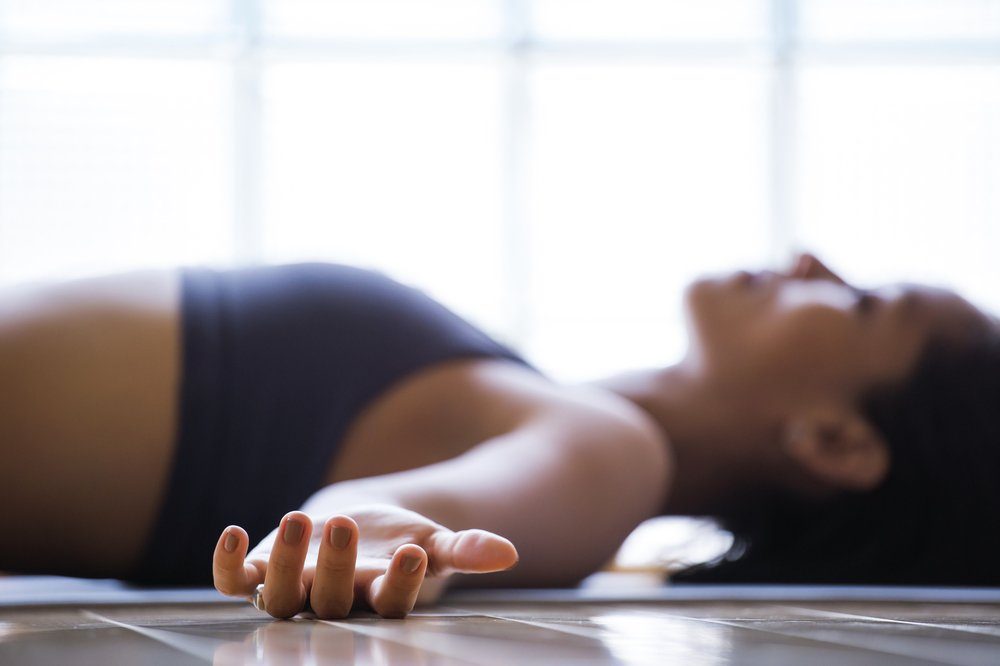
Relaxation is important in order to absorb the benefits of the dynamic, cleansing practice of Yoga (Eight-limbs breath-synchronized movement and balance). Relaxation is best practiced after the asanas, but Yoga Nidra can be practiced separately, after work or before going to sleep, to shift into a different mind-set and to de-stress at the end of your day. Many of us think we are relaxing by sipping a pina colada or sitting in front of the TV with a coffee, but this is sensory diversion rather than relaxation, and many of us go to sleep with unresolved tensions, just as we need to process and digest food, we need to process and digest emotions and experiences. Otherwise we accumulate mental and emotional, as well as physical, toxins, leading to psychosomatic, i.e. mind/body related disease.
Tension can be,
- MUSCULAR:
This affects the nervous system, and causes endocrine (hormonal) imbalances. - EMOTIONAL:
Stemming from conflicting dualities, i.e. love/hate, success/failure, happiness/unhappiness, and unexpressed emotions. - MENTAL:
Brought about the excessive mental activities, too much thinking.
Yoga Nidra, as sleep with a trace of awareness, is a science of relaxation, offering techniques to drop the conscience mind and dive deep into the realms of the subconscious to release tensions and establish harmony in all respects of our being. It involves the practice of sense-withdrawal, pratyahara, the fifth limb of yoga. It is believed that in order for there to be balanced functioning, we need harmony between the upper brain (consciousness) and the lower brain (the seat of the sub- consciousness). Conflict between the two creates a dichotomy in human nature. There also needs to be balance between the left and right hemispheres of the brain.
Yoga Nidra, integrates the logical left side of the brain, which is linear and worldly, with the non-logical right side, wherein our creativity and inspiration lie. This is the part which inspires artists and musicians, often leading them into a world of their own. For example, Van Gogh painted as if he was in a dream state. Mozart composed in his sleep, Goethe solved problems and Einstein accelerated his awareness by exploring the inner realms of the mind.
In the state of Yoga Nidra, the brains focused effortlessly. Positive thoughts can replace negative motivations, intuition can be developed, samskaras lifted and discoveries made.
Tools Of Yoga Nidra
Sankalp:
A positive statement to focus one’s life in a particular direction. It is sown like a seed in the bed of the subconscious mind where it is nurtured.
Rotation of Conciousness:
A systematic exercise to rotate the mind on different body parts, cultivating awareness.
Breathing Awareness:
Cellular breathing cleanses, calms and promotes relaxation and concentration.
Feelings and Sensations:
The pairing of feelings (hot and cold etc.) balances the left and right sides of the brain which helps to bring about emotional balance.
Visualisation/Guided Imagery:
Mental relaxation and self-awareness is developed through images and symbols.
Close:
A peaceful image leading to our positive resolve (sankalpa) before gently awakening.
Preparations
1. The ideal time to practice is early morning or evening, in semi-darkness.
2. Practice in Savasana idealy after asana practice.
3. Beginners should learn with a qualified teacher.
4. Once learnt, you can practice from a tape.
5. Wear warm comfortable clothing. Be snug!
Read slowly the following guided practice, which is an example of Yoga Nidra. Enter into the experience and feel the effects as you read.
Relaxation
Life on the floor, in the Savasana pose and keep warm. Relax your whole body, checking that your spine is straight and your head and neck are released. Let your limbs fall open either side of your spine, while your toes fall outwards and your palms face upwards.
- Close your eyes, allowing them to soften, and turn your attention inwards.
- Take a deep, full breath, and as you exhale, allow your body to drop deep into the mat.
- Become aware of your whole body, and notice any sensations.
- Feel the weight of your body releasing into the floor with every exhaling.
Pause
Sankalp – Affirmation
As you relax, allow a short, positive statement to form in your mind.
Pause
Gently repeat it to yourself, three times, with conviction.
Pause
Yoga nidra is thus a joyous, effortless way to end your yoga practice.
